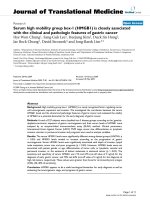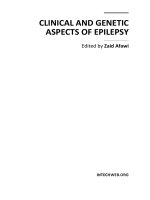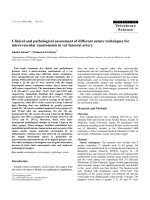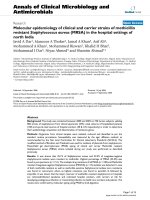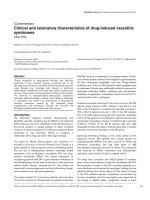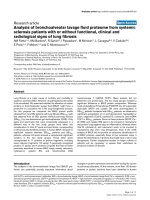Asian pac j cancer prev 2019 clinical and hematological relevance of jak2v617f, calr,
Bạn đang xem bản rút gọn của tài liệu. Xem và tải ngay bản đầy đủ của tài liệu tại đây (404.42 KB, 6 trang )
DOI:10.31557/APJCP.2019.20.9.2775
JAK2, CALR, MPL Mutations in Vietnam
RESEARCH ARTICLE
Editorial Process: Submission:05/31/2019 Acceptance:09/04/2019
Clinical and Hematological Relevance of JAK2V617F, CALR,
and MPL Mutations in Vietnamese Patients with Essential
Thrombocythemia
Hoang Anh Vu1, Tran Thi Thao2, Cao Van Dong3, Nguyen Lam Vuong4, Ho Quoc
Chuong1, Phan Nguyen Thanh Van3, Huynh Nghia2,3, Nguyen Tan Binh3, Phu
Chi Dung3, Phan Thi Xinh2,3*
Abstract
Background: The picture of Vietnamese patients with essential thrombocythemia (ET) remains mostly undetermined.
Our study intended to determine the frequency of JAK2V617F, CALR exon 9, and MPL exon 10 mutations as well as
to analyze clinical characteristics associated with different mutational status in Vietnamese ET patients. Methods: We
explored mutations of JAK2V617F, MPL, and CALR from 395 patients using allele specific oligonucleotide – polymerase
chain reaction and Sanger sequencing techniques; then, the clinical and hematological features were compared according
to mutation patterns. Results: We found that JAK2V617F, CALR exon 9, and MPL exon 10 mutations were present in
56.2%, 27.6%, and 1% of the 395 patients with ET, respectively. Twelve different types of CALR mutation were detected
in 109 patients, with the CALR type 1 mutation (c.1099_1150del; L367fs*46) was the most common, followed by
CALR type 2 mutation (c.1154_1155insTTGTC; K385fs*47). The JAK2V617F-positive patients had older age, higher
white blood cell counts and higher hemoglobin levels but lower platelet counts than patients with CALR mutations
or patients negative for triple tests. There was no significant difference regarding sex ratio, white blood cell counts,
platelet counts and hemoglobin levels among CALR mutation subtypes. Conclusion: we reported high frequency of
JAK2V617F, CALR, and MPL mutations in Vietnamese patients with ET and underscored the importance of combined
genetic tests for diagnosis and classification of ET into different subtypes.
Keywords: Essential thrombocythemia- JAK2V617F- CALR- MPL- Vietnam
Asian Pac J Cancer Prev, 20 (9), 2775-2780
Introduction
Essential thrombocythemia (ET), a subtype of the
BCR-ABL1-negative myeloproliferative neoplasms
(MPNs), is a clonal hematopoietic stem cell disorder
characterized by an isolated thrombocytosis and associated
with complications such as thrombosis, hemorrhage, and
progression to myelofibrosis or acute myeloid leukemia.
The three most common BCR-ABL1-negative MPNs
are polycythemia vera (PV), essential thrombocythemia
(ET), and primary myelofibrosis (PMF). In 2005, the
discovery of JAK2V617F mutation created a breakthrough
in the diagnosis of BCR-ABL1-negative MPNs (Campbell
et al., 2005; James et al., 2005; Kralovics et al., 2005).
The JAK2V617F was present in roughly 90% of patients
with PV and in 50% to 60% of those with ET or PMF.
In addition, MPL exon 10 mutations (mainly involving
codon W515) were found in 5% to 10% of patients with
JAK2V617F-negative ET and PMF (Pardanani et al.,
2006; Pikman et al., 2006). Recently, novel frameshift
mutations in exon 9 of the calreticulin (CALR) gene were
identified in ET or PMF patients without JAK2 and MPL
mutations (Nangalia et al., 2013). Approximately 70
different indels in CALR exon 9 were classified into CALR
type 1 (c.1099_1150del; L367fs*46: 50% of all types),
CALR type 2 (c.1154_1155insTTGTC; K385fs*47: 30%
of all types), and CALR other types (Al Assaf et al., 2015;
Kim et al., 2015). The somatic mutations in JAK2, CALR,
and MPL were included in the World Health Organization
(WHO) classification of MPNs (Arber et al., 2016).
Several studies have shown that JAK2V617F-mutated
ET patients had older age, lower platelet counts, higher
hemoglobin levels, higher leukocyte counts, and higher
thrombotic risk compared with CALR-mutated cases (Al
Assaf et al., 2015; Cazzola and Kralovics, 2014; Tefferi
et al., 2014). However, CALR-mutated ET had a relatively
Center for Molecular Biomedicine, 2Department of Hematology, Faculty of Medicine, 4Department of Medical Statistics and
Informatics, Faculty of Public Health, University of Medicine and Pharmacy at Ho Chi Minh City, 3Ho Chi Minh City Blood
Transfusion and Hematology Hospital, Ho Chi Minh City, Vietnam. *For Correspondence:
1
Asian Pacific Journal of Cancer Prevention, Vol 20
2775
Hoang Anh Vu et al
higher risk of myelofibrotic transformation, especially in
cases with CALR type 1 mutation (Pietra et al., 2016).
To the best of our knowledge, the characteristics of
Vietnamese patients with ET remains mostly undetermined.
In this study, we investigated the profiles of JAK2V617F,
MPL, and CALR mutations in Vietnamese ET patients
using allele specific oligonucleotide – polymerase chain
reaction (ASO-PCR) and conventional Sanger sequencing
method. The clinical and hematological features were
compared according to mutation patterns.
Materials and Methods
Patients and samples
This was a retrospective study of 395 patients
diagnosed with ET between 2008 and 2017 at Blood
Transfusion and Hematology Hospital at Ho Chi Minh
City, Vietnam. The diagnosis of ET was established based
on the 2008 WHO diagnostic criteria (Campo et al., 2011).
In brief, patient was diagnosed with ET when he/she had
thrombocytosis, megakaryocyte proliferation, and did
not meet WHO criteria for other MPNs, myelodysplastic
syndrome (MDS) or myeloid neoplasm. Clinical and
hematological findings at diagnosis were obtained by
reviewing the medical records. Written informed consents
for mutation analyses were obtained from patients
enrolled in this study. Genomic DNA was extracted from
peripheral blood samples using the GeneJET Genomic
DNA Purification Kit (Thermo Scientific, Waltham, MA,
USA) according to the manufacturer’s instruction.
Mutation analysis
All primers used in this study were newly designed.
All 395 samples were assessed for JAK2V617F status
using ASO-PCR technique. Genomic DNA was amplified
in a 35-cycle PCR reaction at an annealing temperature
of 60oC using three primers. The reaction contained
25 – 50 ng of genomic DNA, 1X PCR Buffer, 200 µM
each dNTP, 0.5 U Taq Hot Start Polymerase (Takara
Bio, Shiga, Japan), 0.2 µM common forward primer, 0.1
µM each of reverse primers. The mutant allele showed
two bands at 453 base pairs (bp) and 279 bp, while the
wild-type allele had only one band at 453 bp. Primers
were as follows: reverse wild-type – specific primer,
5’-attgctttcctttttcacaagat-3’; reverse mutant – specific
primer, 5’-gttttacttactctcgtctccacaaaa-3’; and common
forward primer, 5’-tcctcagaacgttgatggcag-3’.
Patients with non-mutated JAK2V617F were further
evaluated for CALR exon 9 and MPL exon 10 mutations
using Sanger sequencing method. The CALR exon 9 was
amplified with primers CALR-F (5’-gaaaccctgtccaaagcaag
-3’) and CALR-R (5’-agagacattatttggcgcgg-3’);
while MPL exon 10 was amplified with primers
MPL-F (5’-tttgggtcaaacagacgctg-3’) and MPL-R
(5’-cacagagcgaaccaagaatg-3). Each reaction consists of
1X PCR Buffer, 1.5 mM MgCl2, 200 µM each dNTP, 0.5
U Taq Hot Start Polymerase (Takara Bio), 0.1 µM each
forward and reverse primers, and 25 – 50 ng of genomic
DNA. PCR involved an initial denaturation at 98°C for
3 min followed by 40 cycles of 98°C for 10 sec, 60°C
for 30 sec, and 72°C for 1 min with a final elongation
2776
Asian Pacific Journal of Cancer Prevention, Vol 20
of 72°C for 5 min. PCR products were checked for size
and purity using 1.5% agarose gel electrophoresis. PCR
products were purified enzymatically using ExoSAP IT™
PCR Product Cleanup Reagent (Thermo Scientific) for
removal of excess primers and dNTPs prior to Sanger
sequencing using a BigDye Terminator v3.1 Kit and ABI
3500 Genetic Analyzer (Applied Biosystems, Foster City,
CA, USA). PCR fragments were sequenced and analyzed
in both directions.
Statistical analysis
The clinical and hematological findings were
summarized by each of the four groups of mutational
status (JAK2, CALR, MPL, and triple-negative) and
were compared between each pair of these groups using
two-sided Fisher’s exact test for categorical variables
and Mann-Whitney U test for numeric variables, where
appropriate. The thrombotic-event-free survival rate
was described by mutational status using Kaplan-Meier
estimate. Statistical significance was defined as P-value
less than 0.05. All statistical analyses were performed
using the statistical software R version 3.4.4.
Results
Baseline clinical characteristics and prevalence of
mutation
Among 395 patients diagnosed with ET, the follow-up
duration ranged from 1 to 13 years, with the median
length of follow-up of 3 years. The baseline clinical
characteristics are shown in Table 1. There were more
females than males (249/146). The median age was
54 years and more than 75% of the patients were
middle-aged or older. There were 34 patients (8.6%)
with history of arterial thrombotic diseases. According to
the IPSET-thrombosis risk score, 130 patients (32.9%)
had high risk and 112 patients (28.4%) had intermediate
risk of thrombosis. The laboratory data showed normal
median values of red blood cell (RBC) counts, hemoglobin
(HGB) concentration, and white blood cell (WBC) counts.
The median platelet count was 1037 × 109/L. There were
also high values of megakaryocytes, lactate dehydrogenase
(LDH), and serum uric acid.
Two hundred twenty-two patients (56.2%), 109 patients
(27.6%), and 4 patients (1%) harbored JAK2V617F
mutation, CALR mutations, and MPL mutations,
respectively; leaving 60 patients (15.2%) negative
for all three mutational tests. Of 109 CALR-mutated
patients, CALR type 1 mutation (c.1099_1150del) was
the most common, accounting for 61 patients (56%).
Thirty-six patients (33%) carried CALR type 2 mutation
(c.1154_1155insTTGTC). In the remaining 12 cases
(11%), ten types of CALR mutations were detected as
shown in Table 2. Four different types of MPL exon 10
mutations detected were S505N, W515K, W515L, and
W515S.
Clinical characteristics with different mutational status
Clinical characteristics by mutational groups are
shown in Table 3.There was no significant difference in
sex ratio between groups. Compared to JAK2-mutated
DOI:10.31557/APJCP.2019.20.9.2775
JAK2, CALR, MPL Mutations in Vietnam
Table 1. Baseline Characteristics and Prevalence of
Mutations in Patients with Essential Thrombocythemia
Characteristics
Summary statistics
Number of patients, n
395
Male, n (%)
146 (37.0)
Age (years), median (IQR)
54 (41, 66)
Comorbidities, n (%)
- Hypertension
85 (21.5)
- Dislipidemia
38 (9.6)
- Arterial thrombosis history
34 (8.6)
- Diabetes
19 (4.8)
IPSET-thrombosis risk, n (%)
- Low
153 (38.7)
- Intermediate
112 (28.4)
- High
130 (32.9)
Laboratory data, median (IQR)
- RBC, ´ 1012/L
4.5 (4.0, 4.9)
- HGB, g/dL
12.5 (11.2, 13.9)
- WBC, ´ 10 /L
12.1 (9.6, 16.4)
9
- Platelets, ´ 109/L
- Megakaryocyte
a
1037 (793, 1342)
80 (50, 100)
- LDH, IU/Lb
258 (217, 363)
- Acid uric, mg/dLc
318 (260, 385)
Mutation profiles, n (%)
- JAK2
222 (56.2)
- CALR
109 (27.6)
CALR type 1
61 (15.4)
CALR type 2
36 (9.1)
CALR other types
12 (3.0)
- MPL
- Triple-negative
4 (1.0)
60 (15.2)
, The number of patients was 315; b, The number of patients
was 302; c, The number of patients was 362; HGB, hemoglobin;
IPSET, International Prognostic Score for Thrombosis in Essential
Thrombocythemia; IQR, interquartile range; LDH, lactate
dehydrogenase; RBC, red blood cell; WBC, white blood cell.
a
Table 2. Mutational Characteristics of Patients with
CALR Mutation
CALR mutation type
n
%
c.1099_1150del
p.L367fs*46
61
56
c.1154_1155insTTGTC
p.K385fs*47
36
33
c.1100_1145del
p.L367fs*48
3
11
c.1105_1138del
p.E369fs*50
1
c.1121_1139del
p.K374fs*50
1
c.1124_1142del
p.K375fs*49
1
c.1147_1151>TGGT
p.E383fs*47
1
c.1149_1150insCAGAG
p.D384fs*48
1
c.1149_1154>TCCTTGTC
p.E383fs*48
1
c.1153delA
p.K385fs*45
1
c.1116_1146del
p.D373fs*47
1
c.1129_1140>CTTTGCGA
p.K377fs*52
1
Total
109
100
patients (JAK2 group), CALR-mutated (CALR group)
and triple-negative patients (triple-negative group) were
significantly younger (JAK2 group: 57 years; CALR
group: 51 years; and triple-negative group: 45 years),
had lower risk of thrombotic events based on IPSETthrombosis risk score, showed lower RBC counts (JAK2
group: 4.8 × 1012/L; CALR group: 4.2 × 1012/L; and
triple-negative group: 4.2 × 1012/L), lower HGB levels
(JAK2 group: 13.2 g/dL; CALR group: 11.8 g/dL; and
triple-negative group: 11.5 g/dL), lower WBC counts
(JAK2 group: 14 × 109/L; CALR group: 9.7 × 109/L;
and triple-negative group: 11.3 × 109/L), higher platelet
counts (JAK2 group: 950 × 109/L; CALR group: 1207 ×
109/L; and triple-negative group: 1153 × 109/L), and lower
serum uric acid concentration (JAK2 group: 335 mg/
dL; CALR group: 296 mg/dL; and triple-negative group:
302 mg/dL). No significant difference was observed
concerning hepatomegaly, splenomegaly, and thrombotic
events between these three groups. Two patients died
Figure 1. Kaplan-Meier Curves for Thrombotic-event-free Survival by Mutational Status
Asian Pacific Journal of Cancer Prevention, Vol 20
2777
Hoang Anh Vu et al
Table 3. Clinical and Laboratory Features Stratified by Mutational Status
Characteristics
JAK2 (1)
CALR (2)
MPL (3)
Triple-negative(4)
Number of
patients, n
222
109
4
60
Male, n (%)
87 (39.2)
35 (32.1)
3 (75.0)
21 (35.0)
Age, years
57 (45, 68)
51 (41, 61)
71 (56, 77)
45 (32, 59)
IPSET-thrombosis
risk group, n (%)
- Low
P1vs.2
P1vs.3
P1vs.4
P2vs.3
P2vs.4
P3vs.4
0.227
0.304
0.654
0.110
0.735
0.144
0.005
0.379
<0.001
0.186
0.065
0.138
<0.001
<0.001
<0.001
0.096
0.630
0.056
0.507
0.657
1 (0.5)
95 (87.2)
2 (50.0)
55 (91.7)
- Intermediate
98 (44.1)
10 (9.2)
1 (25.0)
3 (5.0)
- High
123 (55.4)
4 (3.7)
1 (25.0)
2 (3.3)
RBC, ´ 1012/L
4.8 (4.3, 5.3)
4.2 (3.9, 4.5)
4.4 (3.8, 4.9)
4.2 (3.7, 4.5)
<0.001
0.282
<0.001
0.756
HGB, g/dL
13.2 (11.8, 14.4)
11.8 (10.8, 12.8)
11.2 (10.2, 12.4)
11.5 (10.0, 12.6)
<0.001
0.101
<0.001
0.603
0.112
0.989
WBC, ´ 109/L
14.0 (10.8, 18.4)
9.7 (8.1, 11.9)
6.3 (5.3, 7.5)
11.3 (9.6, 13.8)
<0.001
0.001
<0.001
0.014
0.017
0.007
Platelets, ´ 109/L
950 (755, 1178)
1207 (900, 1477)
1111 (938, 1318)
1153 (998, 1453)
<0.001
0.291
<0.001
0.852
0.948
0.760
Megakaryocyte
80 (50, 100)
60 (30, 100)
30 (30, 30)
80 (58, 100)
0.015
0.200
0.391
0.370
0.011
0.162
LDH, IU/L
273 (224, 352)
263 (223, 376)
230 (197, 434)
249 (190, 398)
0.796
0.679
0.250
0.579
0.189
0.856
Acid uric, mg/dL
335 (279, 419)
296 (242, 352)
341 (294, 373)
302 (242, 364)
<0.001
0.804
0.030
0.510
0.689
0.721
Hepatomegaly,
n (%)
10 (4.5)
4 (3.7)
0 (0)
3 (5.0)
1
1
1
1
0.700
1
Splenomegaly,
n (%)
29 (13.1)
7 (6.4)
0 (0)
4 (6.7)
0.090
1
0.256
1
1
1
Thrombotic
events, n (%)
6 (2.7)
2 (1.8)
2 (50.0)
0 (0)
1
0.006
0.348
0.006
0.539
0.003
Mortality, n (%)
1 (0.5)
1 (0.9)
0 (0)
0 (0)
0.551
1
1
1
1
-
Summary statistic is absolute count (%) for categorical variables and median (IQR) for continuous data; P values were calculated between patients
in each pair of mutations. Significance values are in boldface; HGB, hemoglobin; IPSET, International Prognostic Score for Thrombosis in Essential
Thrombocythemia; IQR, interquartile range; LDH, lactate dehydrogenase; RBC,red blood cell; WBC, white blood cell.
Table 4. Clinical and Laboratory Features Stratified by CALR Mutation Subtypes
Characteristics
Number of patients, n
CALR type 1 (1)
CALR type 2 (2)
CALR other types (3)
61
36
12
P1vs.2
P1vs.3
P2vs.3
Male, n (%)
17 (27.9)
11 (30.6)
7 (58.3)
0.819
0.051
0.101
Age, years
50.0 (42.0, 62.0)
50.5 (37.2, 60.2)
60.0 (56.2, 61.5)
0.976
0.052
0.045
0.641
0.757
0.482
53 (86.9)
30 (83.3)
12 (100.0)
- Intermediate
5 (8.2)
5 (13.9)
0 (0.0)
- High
3 (4.9)
1 (2.8)
0 (0.0)
IPSET-thrombosis risk group, n (%)
- Low
RBC, ´ 10 /L
4.2 (3.9, 4.5)
4.2 (4.0, 4.4)
4.4 (4.2, 4.7)
0.991
0.368
0.289
11.8 (10.5, 12.8)
11.7 (11.1, 12.6)
12.3 (11.9, 13.0)
0.646
0.198
0.359
10.3 (8.3, 12.2)
9.3 (7.8, 11.0)
9.7 (8.8, 11.2)
0.055
0.503
0.475
Platelets, ´ 10 /L
1187 (928, 1473)
1277 (989, 1560)
917 (788, 1237)
0.378
0.228
0.116
Megakaryocyte
60 (30, 80)
80 (30, 100)
50.0 (30, 70)
0.391
0.258
0.095
LDH, IU/L
279 (223, 384)
250 (222, 339)
256 (232, 494)
0.655
0.917
0.725
Acid uric, mg/dL
296 (248, 354)
293 (238, 350)
313 (229, 372)
0.789
0.641
0.482
12
HGB, g/dL
WBC, ´ 10 /L
9
9
Hepatomegaly, n (%)
2 (3.3)
0 (0)
2 (16.7)
0.528
0.124
0.059
Splenomegaly, n (%)
3 (4.9)
2 (5.6)
2 (16.7)
1
0.187
0.257
Thrombotic events, n (%)
2 (3.3)
0 (0)
0 (0)
0.528
1
-
Mortality, n (%)
1 (1.7)
0 (0)
0 (0)
1
1
-
Summary statistic is absolute count (%) for categorical variables and median (IQR) for continuous data; P values were calculated between patients
in each pair of mutations. Significance values are in boldface. HGB, hemoglobin; IPSET, International Prognostic Score for Thrombosis in Essential
Thrombocythemia; IQR, interquartile range; LDH, lactate dehydrogenase; RBC, red blood cell; WBC, white blood cell.
during follow-up period. Kaplan-Meier estimates for
thrombotic-event-free survival by mutational status
were shown in Figure 1. Among four cases with MPL
mutation, two experienced thrombotic events with no
2778
Asian Pacific Journal of Cancer Prevention, Vol 20
mortality. There was no significant difference among
JAK2, CALR, and triple-negative groups regarding the
event-free survival estimate.
DOI:10.31557/APJCP.2019.20.9.2775
JAK2, CALR, MPL Mutations in Vietnam
Clinical characteristics with different CALR mutation
subtypes
The clinical characteristics by CALR mutation
subtypes are shown in Table 4. While patients with CALR
types 1 and types 2 were younger than other CALR types,
there was no significant difference concerning sex ratio
and IPSET-thrombosis risk score between these subtypes.
Compared with CALR type 1, CALR type 2 patients seemed
to have lower WBC counts, higher platelet counts, and
lower LDH concentration; however, the differences were
not statistically significant. Hepatomegaly, splenomegaly,
thrombotic events, and mortality were rare in all subtypes.
Discussion
This is the first comprehensive study to describe
the profile of Vietnamese patients with ET. Using
ASO-PCR and conventional Sanger sequencing method,
we found that 84.8% of 395 ET patients carried
JAK2V617F, CALR, or MPL mutations, underscoring the
importance of combined genetic tests for diagnosis of ET
patients. The JAK2V617F was the most frequent mutation
(56.2%), followed by CALR mutation (27.6%), which
is consistent with Chinese (Lin et al., 2015), Japanese
(Misawa et al., 2018), Argentinean (Ojeda et al., 2018),
and American (Tefferi et al., 2014) ET populations.
However, the frequency of CALR exon 9 mutations in our
study is higher than that of Thai (Limsuwanachot et al.,
2017), Korean (Kim et al., 2015) , Italian (Rotunno et al.,
2014) , Polish (Wojtaszewska et al., 2015) , and Brazilian
(Nunes et al., 2015) ET patients; in those populations
the mutation rate of CALR exon 9 mutations ranged
from 12.5% to 15.5%. Twelve different types of CALR
mutation including deletion, insertion and complex indels
were found in our study. Type 1 (c.1099_1150del), type 2
(c.1154_1155insTTGTC), and other indels were detected
in 56%, 33%, and 11%, respectively, in good agreement
with previous reports (Al Assaf et al., 2015; Klampfl et al.,
2013; Nangalia et al., 2013; Tefferi et al., 2014).
Among four different types of MPL exon 10 mutations
detected (S505N, W515K, W515L and W515S), S505N
was reported as a founder mutation in several pedigrees
with familial thrombocytosis (Ding et al., 2004). However,
it was also found as an acquired somatic mutation in rare
ET patients (Beer et al., 2008; Vainchenker and Kralovics,
2017). In this study, the patient carrying MPLS505N was
an 80-year-old man with HGB level of 10.2 g/dL, platelet
count of 1,421 x 109/L, and WBC count of 5.71 x 109/L
at diagnosis. He had history of thrombotic event and
developed secondary bone marrow fibrosis three years
after diagnosis.
Among JAK2V617, CALR and triple-negative
groups, we showed here that triple-negative ET patients
were the youngest, quite similar to previous studies
(Al Assaf et al., 2015; Ojeda et al., 2018). Also, consistent
with previous reports, patients with JAK2 mutations had
significantly higher HGB level, higher RBC and WBC
counts, and higher thrombosis risk score, but lower platelet
counts compared with patients with CALR mutations or
triple-negative for mutations (Al Assaf et al., 2015; Ojeda
et al., 2018; Rumi et al., 2014; Tefferi et al., 2014).
When comparing the clinical and hematological
findings among CALR type 1, CALR type 2, and other
CALR types, we found that three CALR mutation groups
were similar in their sex ratio, IPSET-thrombosis risk
score, HGB level and WBC counts. In a similar cohort
study of 402 ET patients, Tefferi et al concluded that
patients with CALR type 2 had significantly higher
platelet count compared with CALR type 1 (Tefferi et al.,
2014). In our study, patients with CALR type 2 showed a
tendency of higher platelet counts; however, there was no
significant difference among these three CALR mutation
groups (Table 3).
Within a 3-year median time of follow-up, thrombotic
events and mortality were rare, with two death cases and
ten thrombotic events. Long-term follow-up is required
to further explore thrombotic events and mortality rate
based on mutational groups. A limitation of our study is
that this was a single-center retrospective study with a
limited sample size. Therefore, only four patients harbored
MPL mutations detected, with two of them experiencing
thrombotic events. Although the prevalence of thrombotic
events in the MPL mutation group was higher than in
other groups, we could not conclude that this group was
associated with worse outcome due to small number of
patients.
In conclusion, this study is the first comprehensive
investigation of gene mutations in Vietnamese patients
with ET. The combined genetic tests can clarify
approximately 85% of the ET patients with JAK2V617F,
CALR exon 9, and MPL exon 10 mutations, which might
improve the diagnosis and classification of ET in Vietnam.
Acknowledgements
The authors would like to thank Dr. Nguyen Thi
Hong Hoa for assistance in providing samples and patient
information.
Conflict of interest
The authors have no conflicts of interest to declare.
Funding information
No specific funding was available for this project.
Ethical issue
The study was approved by the ethics committee of
the University of Medicine and Pharmacy at Ho Chi Minh
City, Vietnam (17551-DHYD).
References
Al Assaf C, Van Obbergh F, Billiet J, et al (2015). Analysis of
phenotype and outcome in essential thrombocythemia with
CALR or JAK2 mutations. Haematologica, 100, 893-7.
Arber DA, Orazi A, Hasserjian R, et al (2016). The 2016 revision
to the World Health Organization classification of myeloid
neoplasms and acute leukemia. Blood, 127, 2391-405.
Beer PA, Campbell PJ, Scott LM, et al (2008). MPL mutations
in myeloproliferative disorders: analysis of the PT-1 cohort.
Blood, 112, 141-9.
Campbell PJ, Scott LM, Buck G, et al (2005). Definition of
subtypes of essential thrombocythaemia and relation to
Asian Pacific Journal of Cancer Prevention, Vol 20
2779
Hoang Anh Vu et al
polycythaemia vera based on JAK2 V617F mutation status:
a prospective study. Lancet, 366, 1945-53.
Campo E, Swerdlow SH, Harris NL, et al (2011). The 2008 WHO
classification of lymphoid neoplasms and beyond: evolving
concepts and practical applications. Blood, 117, 5019-32.
Cazzola M, Kralovics R (2014). From Janus kinase 2 to
calreticulin: the clinically relevant genomic landscape of
myeloproliferative neoplasms. Blood, 123, 3714-9.
Ding J, Komatsu H, Wakita A, et al (2004). Familial essential
thrombocythemia associated with a dominant-positive
activating mutation of the c-MPL gene, which encodes for
the receptor for thrombopoietin. Blood, 103, 4198-200.
James C, Ugo V, Le Couédic JP, et al (2005). A unique clonal
JAK2 mutation leading to constitutive signalling causes
polycythaemia vera. Nature, 434, 1144-8.
Kim SY, Im K, Park SN, et al (2015). CALR, JAK2, and MPL
mutation profiles in patients with four different subtypes
of myeloproliferative neoplasms: primary myelofibrosis,
essential thrombocythemia, polycythemia vera, and
myeloproliferative neoplasm, unclassifiable. Am J Clin
Pathol, 143, 635-44.
Klampfl T, Gisslinger H, Harutyunyan AS, et al (2013). Somatic
mutations of calreticulin in myeloproliferative neoplasms.
N Engl J Med, 369, 2379-90.
Kralovics R, Passamonti F, Buser AS, et al (2005). A gain-offunction mutation of JAK2 in myeloproliferative disorders.
N Engl J Med, 352, 1779-90.
Limsuwanachot N, Rerkamnuaychoke B, Chuncharunee S, et al
(2017). Clinical and hematological relevance of JAK2 V617F
and CALR mutations in BCR-ABL-negative ET patients.
Hematology, 22, 599-606.
Lin Y, Liu E, Sun Q, et al (2015). The prevalence of JAK2,
MPL, and CALR mutations in Chinese patients with
BCR-ABL1-negative myeloproliferative neoplasms. Am J
Clin Pathol, 144, 165-71.
Misawa K, Yasuda H, Araki M, et al (2018). Mutational subtypes
of JAK2 and CALR correlate with different clinical features
in Japanese patients with myeloproliferative neoplasms. Int
J Hematol, 107, 673-80.
Nangalia J, Massie CE, Baxter EJ, et al (2013). Somatic CALR
mutations in myeloproliferative neoplasms with nonmutated
JAK2. N Engl J Med, 369, 2391-405.
Nunes DP, Lima LT, Chauffaille Mde L, et al (2015). CALR
mutations screening in wild type JAK2(V617F) and
MPL(W515K/L) Brazilian myeloproliferative neoplasm
patients. Blood Cells Mol Dis, 55, 236-40.
Ojeda MJ, Bragos IM, Calvo KL, et al (2018). CALR, JAK2
and MPL mutation status in Argentinean patients with BCRABL1- negative myeloproliferative neoplasms. Hematology,
23, 208-11.
Pardanani AD, Levine RL, Lasho T, et al (2006). MPL515
mutations in myeloproliferative and other myeloid disorders:
a study of 1182 patients. Blood, 108, 3472-6.
Pietra D, Rumi E, Ferretti VV, et al (2016). Differential clinical
effects of different mutation subtypes in CALR-mutant
myeloproliferative neoplasms. Leukemia, 30, 431-8.
Pikman Y, Lee BH, Mercher T, et al (2006). MPLW515L is a
novel somatic activating mutation in myelofibrosis with
myeloid metaplasia. PLoS Med, 3, 270.
Rotunno G, Mannarelli C, Guglielmelli P, et al (2014). Impact
of calreticulin mutations on clinical and hematological
phenotype and outcome in essential thrombocythemia.
Blood, 123, 1552-5.
Rumi E, Pietra D, Ferretti V, et al (2014). JAK2 or CALR mutation
status defines subtypes of essential thrombocythemia with
substantially different clinical course and outcomes. Blood,
123, 1544-51.
2780
Asian Pacific Journal of Cancer Prevention, Vol 20
Tefferi A, Wassie EA, Guglielmelli P, et al (2014). Type 1 versus
Type 2 calreticulin mutations in essential thrombocythemia:
a collaborative study of 1027 patients. Am J Hematol, 89,
121-4.
Vainchenker W, Kralovics R (2017). Genetic basis and molecular
pathophysiology of classical myeloproliferative neoplasms.
Blood, 129, 667-79.
Wojtaszewska M, Iwola M, Lewandowski K (2015). Frequency
and molecular characteristics of calreticulin gene (CALR)
mutations in patients with JAK2 -negative myeloproliferative
neoplasms. Acta Haematol, 133, 193-8.
This work is licensed under a Creative Commons AttributionNon Commercial 4.0 International License.
